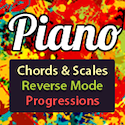Vicente Scaramuzza was an Italian piano teacher who founded his school in Buenos Aires, Argentina in 1912 and dedicated his entire life to music education. Even though he was a “virtuoso”, his true passion was teaching and made him one of the founders of the Argentinian pianistic tradition, counting among their disciples Martha Argerich and Bruno Leonardo Gelber. Here’s an overview of his method:
The core of Scaramuzza’s legacy is clarity and conceptualization. He pragmatically structured his piano teaching, ordering it in steps, movements, finger and arms positions, and that’s the main difference between his technique and other piano methods. His anatomy studies allowed him to build a physically relaxed playing style. There’s no unnecessary stress on shoulders, arms, or fingers, solving a major technical problem and making room for what really matters: the search for the ideal sound. The recreation of the emotion and the concept that each composer poured into their works.
Our piano lessons at WKMT are taught utilizing this amazing technique because we concluded that it is the clearest method to teach and learn. Our director, Juan José Rezzuto, was a student of pianist Bruno Leonardo Gelber, who was a direct disciple of Scaramuzza, so his instruction as a professional pianist was directed under this method. It’s wonderful to talk about the subjective aspects of interpretation and to unleash a romantic view of it, but when it comes to actually learn to play the piano, the approach needs to be practical and understandable.
Why is the Vincente Scaramuzza technique so powerful?
It helps you to bring your piano performances to life. There are five main categories to this piece: Arm Movement, Forearm Movement, Finger movement, Rotational Movement, and Wrist Movement. These will help you build on your strengths and express appropriately the nature of the piece you are performing:
Arm Movement
Used at the beginning of a piece. Place your arm at a 90 degree angle, with relaxed muscles throughout your shoulders, back and arms. Release your arm as it falls freely with no tension onto the start notes of the piece. Then, you are ready to begin.
Forearm Movement
This movement is great for aspects of pieces such as chords. The power it allows you to exert is unlike any other. Slowly lift up your forearm, bringing your wrist along and make sure your fingers are in the close circumference of the notes you are about to play. Then, without any tension, bring the lower arm back down to standard position and listen to the sound of the chord fill the room with both assertion and meaning.
Finger Movement
This arguably is the most important movement of them all, the one we use the most that covers a wide span of uses. Finger movement allows your fingers to become independent and roam freely on their own without any assistance from other body parts. This helps you play quickly, loudly, softly and most important, precisely. This is especially great for scale-like passages and quick rhythms such as semiquavers or even (if you dare) Demi-semi quavers.
Rotation Movement
Ever played a tremolo or a trill and really struggled? An Alberti bass not sounding quite right? Maybe you aren’t using the rotational movement right. The main aspect to note down is the pivot point, you need a focus where your finger (usually your thumb) won’t leave the key, it is always where you are heading towards. Then, slightly tilt your wrist towards the following notes to allow the tone to and precision to shine through.
Wrist Movement
Arguably, wrist movement is known to be one of the hardest movements as it requires you to focus your tension on the upper part of your arm (near the bicep). Great for staccatos, this movement allows you to move your wrist in a short yet quick way that allows notes to become fast and crisp.
The Scaramuzza Piano Technique is used widely in the piano community and it allows you to gain control over the piano like no other. It teaches you to carefully articulate every note exactly how you want it, avoiding slip ups and enhancing your expressive and technical capabilities. If it’s something you aren’t knowledgeable on then it’s definitely worth researching, because why not allow yourself to become a better pianist?
Article by Juan Rezzuto, Pianist, Composer, Teacher, Director of WKMT Piano School London.
Bibliography
Lian, M. (2013) “The pedagogical Legacy of Vicente Scaramuza: The Relationship Between Anatomy of the Hand, Tone Production, and Musical Goals” Doctoral Document For the Degree of Doctor of Musical Arts, Major: Music. University of Nebraska.
Oubiña de Castro, M.R. (1973) “Enseñanzas de un Gran Maestro, Vicente Scaramuzza”. Buenos Aires. Ed. Ossorio.
WKMTA Piano Studios London is our newest advertiser here on Music Matters Blog, and we are grateful for her support of the online music education community! If you are interested in finding out more about how you can promote your company, event, or product, just send us an e-mail and we will let you know about our advertising packages.














Prtal Berita says
Who and who are the famous students of Vicente Scaramuzza in the field of piano music?
Regard Prtal Berital